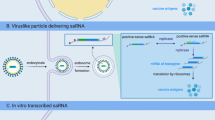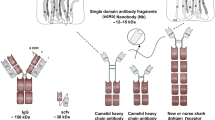Abstract
The C-terminal region of the Leptospiral immunoglobulin-like A protein (LigA) contains six carboxy-terminal Ig-like repeat domains (LigANI). Subunit vaccine preparations based on recombinant LigANI produced in Escherichia coli, are promising vaccine candidates, albeit with variable efficacy. In the present study, LigANI was expressed in the methylotrophic yeast Pichia pastoris using a 12 L bioreactor to produce mannosylated LigANI (mLigANI) for use in a vaccine preparation against leptospirosis. Hamsters immunized with a mLigANI vaccine preparation produced a significant IgG antibody response (P < 0.001) and were protected (83.3 %; P < 0.001) against lethal challenge with 36× LD50 of a virulent strain of L. interrogans serovar Copenhageni. A vaccine preparation based on demannosylated mLigANI (nmLigANI) elicited an immune response in hamsters, but did not afford protection. The production of mLigANI in bioreactor by P. pastoris yielded ~50 mg L−1 of recombinant protein. P. pastoris is a potential platform for the production of leptospiral antigens on an industrial scale. The results demonstrate that LigANI secreted by P. pastoris on mannosylated form (mLigANI) protect hamsters as subunit vaccine of L. interrogans lethal infection.


Similar content being viewed by others
References
Adler B, de la Pena MA (2010) Leptospira and leptospirosis. Vet Microbiol 140:287–296
Bharti AR, Nally JE, Ricaldi JN et al (2003) Leptospirosis: a zoonotic disease of global importance. Lancet Infect Dis 3:757–771
McBride AJ, Athanazio DA, Reis MG et al (2005) Leptospirosis. Curr Opin Infect Dis 18:376–386
Haake DA, Dundoo M, Cader R et al (2002) Leptospirosis, water sports, and chemoprophylaxis. Clin Infect Dis 34:e40–e43
Monahan AM, Miller IS, Nally JE (2009) Leptospirosis: risks during recreational activities. J Appl Microbiol 107:707–716
Reis RB, Ribeiro GS, Felzemburgh RD et al (2008) Impact of environment and social gradient on Leptospira infection in urban slums. PLoS Negl Trop Dis 2:e228
WHO (2011) Leptospirosis: an emerging public health problem. Wkly Epidemiol Rec 86:45–50
Gouveia EL, Metcalfe J, de Carvalho AL et al (2008) Leptospirosis-associated severe pulmonary hemorrhagic syndrome, Salvador, Brazil. Emerg Infect Dis 14:505–508
Segura ER, Ganoza CA, Campos K et al (2005) Clinical spectrum of pulmonary involvement in leptospirosis in a region of endemicity, with quantification of leptospiral burden. Clin Infect Dis 40:343–351
Faine SB, Adler B, Bolin C, Perolat P (1999) Leptospira and Leptospirosis, 2nd edn. MediSci, Melbourne
Dellagostin OA, Grassmann AA, Hartwig DD et al (2011) Recombinant vaccines against leptospirosis. Hum Vaccin 7:1215–1224
Matsunaga J, Barocchi MA, Croda J et al (2003) Pathogenic Leptospira species express surface-exposed proteins belonging to the bacterial immunoglobulin superfamily. Mol Microbiol 49:929–945
Choy HA, Kelley MM, Chen TL et al (2007) Physiological osmotic induction of Leptospira interrogans adhesion: LigA and LigB bind extracellular matrix proteins and fibrinogen. Infect Immun 75:2441–2450
Choy HA, Kelley MM, Croda J et al (2011) The multifunctional LigB adhesin binds homeostatic proteins with potential roles in cutaneous infection by pathogenic Leptospira interrogans. PLoS One 6:e16879
Cerqueira GM, McBride AJ, Hartskeerl RA et al (2010) Bioinformatics describes novel Loci for high resolution discrimination of Leptospira isolates. PLoS One 5:e15335
McBride AJ, Cerqueira GM, Suchard MA et al (2009) Genetic diversity of the Leptospiral immunoglobulin-like (Lig) genes in pathogenic Leptospira spp. Infect Genet Evol 9:196–205
Koizumi N, Watanabe H (2004) Leptospiral immunoglobulin-like proteins elicit protective immunity. Vaccine 22:1545–1552
Lucas DS, Cullen PA, Lo M et al (2011) Recombinant LipL32 and LigA from Leptospira are unable to stimulate protective immunity against leptospirosis in the hamster model. Vaccine 29:3413–3418
Palaniappan RU, McDonough SP, Divers TJ et al (2006) Immunoprotection of recombinant leptospiral immunoglobulin-like protein A against Leptospira interrogans serovar Pomona infection. Infect Immun 74:1745–1750
Silva EF, Medeiros MA, McBride AJ et al (2007) The terminal portion of leptospiral immunoglobulin-like protein LigA confers protective immunity against lethal infection in the hamster model of leptospirosis. Vaccine 25:6277–6286
Coutinho ML, Choy HA, Kelley MM et al (2011) A LigA three-domain region protects hamsters from lethal infection by Leptospira interrogans. PLoS Negl Trop Dis 5:e1422
Hartwig DD, Oliveira TL, Seixas FK et al (2010) High yield expression of leptospirosis vaccine candidates LigA and LipL32 in the methylotrophic yeast Pichia pastoris. Microb Cell Fact 9:98
Cereghino GP, Cereghino JL, Ilgen C et al (2002) Production of recombinant proteins in fermenter cultures of the yeast Pichia pastoris. Curr Opin Biotechnol 13:329–332
Macauley-Patrick S, Fazenda ML, McNeil B et al (2005) Heterologous protein production using the Pichia pastoris expression system. Yeast 22:249–270
Cregg JM, Cereghino JL, Shi J et al (2000) Recombinant protein expression in Pichia pastoris. Mol Biotechnol 16:23–52
Ko AI, Galvao RM, Ribeiro Dourado CM et al (1999) Urban epidemic of severe leptospirosis in Brazil. Salvador leptospirosis study group. Lancet 354:820–825
Reed LJ (1938) A simple method of estimating fifty percent endpoints. Am J Hyg 27:493–497
Seixas FK, da Silva EF, Hartwig DD et al (2007) Recombinant Mycobacterium bovis BCG expressing the LipL32 antigen of Leptospira interrogans protects hamsters from challenge. Vaccine 26:88–95
Chagas-Junior AD, McBride AJ, Athanazio DA et al (2009) An imprint method for detecting leptospires in the hamster model of vaccine-mediated immunity for leptospirosis. J Med Microbiol 58:1632–1637
Cereghino JL, Cregg JM (2000) Heterologous protein expression in the methylotrophic yeast Pichia pastoris. FEMS Microbiol Rev 24:45–66
Faisal SM, Yan W, Chen CS et al (2008) Evaluation of protective immunity of Leptospira immunoglobulin like protein A (LigA) DNA vaccine against challenge in hamsters. Vaccine 26:277–287
Faisal SM, Yan W, McDonough SP et al (2009) Leptospira immunoglobulin-like protein A variable region (LigAvar) incorporated in liposomes and PLGA microspheres produces a robust immune response correlating to protective immunity. Vaccine 27:378–387
Palaniappan RU, McDonough SP, Divers TJ et al (2006) Immunoprotection of recombinant leptospiral immunoglobulin-like protein A against Leptospira interrogans serovar Pomona infection. Infect Immun 74:1745–1750
Palaniappan RU, Chang YF, Jusuf SS et al (2002) Cloning and molecular characterization of an immunogenic LigA protein of Leptospira interrogans. Infect Immun 70:5924–5930
Raemaekers RJ, de Muro L, Gatehouse JA, Fordham-Skelton AP (1999) Functional phytohemagglutinin (PHA) and Galanthus nivalis agglutinin (GNA) expressed in Pichia pastoris correct N-terminal processing and secretion of heterologous proteins expressed using the PHA-E signal peptide. Eur J Biochem 265:394–403
Daly R, Hearn MT (2005) Expression of heterologous proteins in Pichia pastoris: a useful experimental tool in protein engineering and production. J Mol Recognit 18:119–138
Montesino R, Garcia R, Quintero O et al (1998) Variation in N-linked oligosaccharide structures on heterologous proteins secreted by the methylotrophic yeast Pichia pastoris. Protein Expr Purif 14:197–207
Rudd PM, Elliott T, Cresswell P et al (2001) Glycosylation and the immune system. Science 291:2370–2376
Bretthauer RK, Castellino FJ (1999) Glycosylation of Pichia pastoris-derived proteins. Biotechnol Appl Biochem 30(Pt 3):193–200
Trimble RB, Lubowski C, Hauer CR III et al (2004) Characterization of N- and O-linked glycosylation of recombinant human bile salt-stimulated lipase secreted by Pichia pastoris. Glycobiology 14:265–274
Lam JS, Mansour MK, Specht CA et al (2005) A model vaccine exploiting fungal mannosylation to increase antigen immunogenicity. J Immunol 175:7496–7503
Luong M, Lam JS, Chen J et al (2007) Effects of fungal N- and O-linked mannosylation on the immunogenicity of model vaccines. Vaccine 25:4340–4344
Acknowledgments
We are grateful to Michele dos Santos and Kátia R. Pimenta Cardoso for technical assistance.
This work was supported by CNPq (Grant Number 475830/2012-1) and FAPERGS/ARD-no 003/2012. AJAM and OAD were recipients of research scholarships from CNPq.
Conflict of interest
AJAM and OAD are inventors on a patent submission entitled: LigA and LigB proteins (Leptospiral Ig-like (Lig) domains) for vaccination and diagnosis (Patent nos. BRPI0505529 and WO 2007070996). The other authors declare no conflict of interest.
Author information
Authors and Affiliations
Corresponding author
Electronic supplementary material
Below is the link to the electronic supplementary material.
Rights and permissions
About this article
Cite this article
Hartwig, D.D., Bacelo, K.L., de Oliveira, P.D. et al. Mannosylated LigANI Produced in Pichia pastoris Protects Hamsters Against Leptospirosis. Curr Microbiol 68, 524–530 (2014). https://doi.org/10.1007/s00284-013-0505-4
Received:
Accepted:
Published:
Issue Date:
DOI: https://doi.org/10.1007/s00284-013-0505-4




